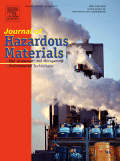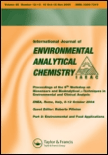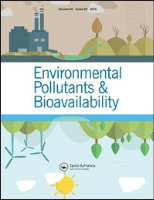
JOURNAL OF HAZARDOUS MATERIALS
Scope & Guideline
Leading Research in Environmental Protection
Introduction
Aims and Scopes
- Hazardous Materials Management and Remediation:
Research on the characterization, treatment, and remediation of various hazardous materials, including heavy metals, organic pollutants, and microplastics, employing advanced techniques such as bioremediation, electrochemical processes, and innovative materials. - Environmental and Health Risk Assessments:
Studies focusing on the risks associated with exposure to hazardous materials, including toxicological assessments, epidemiological studies, and the impact of pollutants on human health and ecosystems. - Advanced Analytical Techniques:
Development and application of novel analytical methods for detecting and quantifying hazardous substances in environmental media, including water, soil, and air, using techniques like mass spectrometry, spectroscopy, and sensor technologies. - Microbial Interactions and Biodegradation:
Investigation of microbial communities and their roles in the degradation of contaminants, including the effects of pollutants on microbial dynamics and the potential for bioremediation. - Material Science Innovations:
Research on the synthesis and application of new materials, such as nanomaterials and metal-organic frameworks (MOFs), for environmental applications, including pollutant capture and sensing.
Trending and Emerging
- Microplastics and Their Ecological Impact:
Research on the occurrence, effects, and remediation of microplastics is gaining momentum, highlighting their pervasive nature and the need for innovative solutions to mitigate their impact on ecosystems. - Sustainable Materials and Green Chemistry:
There is an increasing focus on developing sustainable materials and green chemistry practices that minimize environmental footprints and enhance the recyclability and biodegradability of materials. - Machine Learning and AI in Environmental Science:
The integration of machine learning and artificial intelligence in environmental monitoring and risk assessment is emerging as a significant trend, enabling improved predictions and data analysis. - Bioremediation and Microbial Ecology:
Research into the use of microbial processes for bioremediation is on the rise, with an emphasis on understanding microbial community dynamics and enhancing pollutant degradation. - Chemical Transformation and Degradation Pathways:
Studies exploring the chemical transformation and degradation mechanisms of pollutants, especially in relation to innovative treatment technologies like photocatalysis and electrochemical oxidation, are increasingly relevant.
Declining or Waning
- Traditional Pollutant Treatment Methods:
There has been a noticeable decline in research focused solely on conventional methods for treating hazardous materials, such as basic chemical treatments, as more advanced and sustainable technologies gain traction. - Single-Pollutant Studies:
Research that examines the effects of single pollutants in isolation is becoming less common as the field shifts toward understanding the interactions and cumulative effects of multiple contaminants. - Static Risk Assessment Models:
The reliance on static models for assessing environmental risks is diminishing in favor of dynamic, data-driven approaches that incorporate machine learning and real-time monitoring. - General Environmental Monitoring:
Publications focusing on broad environmental monitoring without specific ties to hazardous materials management are decreasing, as studies become more targeted and specialized.
Similar Journals

BULLETIN OF ENVIRONMENTAL CONTAMINATION AND TOXICOLOGY
Exploring the nexus of contamination and public safety.BULLETIN OF ENVIRONMENTAL CONTAMINATION AND TOXICOLOGY, published by SPRINGER, is a pivotal journal in the fields of Environmental Science, Toxicology, and Public Health. With a strong history of dissemination since its inception in 1966, the journal predominantly focuses on the latest advances in understanding environmental contaminants and their toxicological effects on health and ecosystems. It currently holds a respectable Q2 ranking across multiple categories including Health, Toxicology and Mutagenesis, Medicine (miscellaneous), and Pollution, as per the 2023 metrics. While the journal is not Open Access, it provides an invaluable platform for researchers, professionals, and students seeking to contribute to and stay informed on critical issues regarding environmental hazards and their implications. With an engaged community of scholars and practitioners, this journal continues to be an essential resource for addressing the pressing challenges of environmental contamination and its health impacts, guiding future research and policy decisions.

INTERNATIONAL JOURNAL OF ENVIRONMENTAL ANALYTICAL CHEMISTRY
Connecting science to global environmental challenges.INTERNATIONAL JOURNAL OF ENVIRONMENTAL ANALYTICAL CHEMISTRY, published by Taylor & Francis Ltd, stands as an essential resource in the interdisciplinary field of environmental science and analytical chemistry. With a history dating back to 1971 and a convergence period extending to 2024, this journal addresses urgent global challenges by providing a platform for high-quality research that encompasses pivotal aspects of environmental analysis, pollution, and public health. The journal’s significant impact is reflected in its 2023 rankings, placing it in the second and third quartiles across various relevant categories, including Analytical Chemistry, Environmental Chemistry, and Water Science and Technology. Researchers and practitioners are encouraged to contribute to its wealth of knowledge, making it a vital reference for emerging studies in Health, Toxicology and Mutagenesis and beyond. Although it is not an open-access journal, subscriptions provide unparalleled access to groundbreaking research that can influence both academia and industry practices.

Environmental Pollutants and Bioavailability
Pioneering Studies on Toxicity and BioavailabilityEnvironmental Pollutants and Bioavailability, published by Taylor & Francis Ltd, serves as a critical platform for disseminating high-quality research focused on the interactions between environmental contaminants and biological systems. Since its inception as an Open Access journal in 2019, it has rapidly gained recognition within the scientific community, achieving a commendable Q2 ranking in multiple categories including Chemical Health and Safety, Health, Toxicology and Mutagenesis, and Toxicology for the year 2023. The journal aims to bridge the gap between environmental science and public health by exploring innovative methodologies, risk assessments, and bioavailability studies related to pollutants. Located in the United Kingdom, Environmental Pollutants and Bioavailability is positioned to impact ongoing discourse and research practices in the fields of toxicology and environmental safety, making it an invaluable resource for researchers, professionals, and students dedicated to advancing knowledge in these critical areas.

Reviews of Environmental Contamination and Toxicology
Advancing knowledge in environmental health and toxicology.Reviews of Environmental Contamination and Toxicology is a leading journal published by SPRINGER, dedicated to advancing the understanding of environmental science, toxicology, and public health. Since its inception in 1987, this esteemed journal has established itself as an invaluable resource for researchers and practitioners alike, showcasing a wealth of peer-reviewed articles that delve into the complexities of environmental contaminants and their effects on human health and ecosystems. With an impressive impact factor and consistently ranking in the Q1 category across multiple fields including Health, Toxicology and Mutagenesis, as well as Public Health, this journal commands attention, boasting Scopus rankings that place it among the top-tier publications globally. Researchers will find that the journal provides not only in-depth reviews but also practical implications for policy and practice regarding environmental issues. Located in the heart of New York, Reviews of Environmental Contamination and Toxicology is poised to remain at the forefront of this critical field through 2024 and beyond, making it an essential addition to the library of any environmental health scholar or practitioner.

Journal of Hazardous Materials Letters
Elevating awareness and understanding of hazardous materials.Journal of Hazardous Materials Letters, published by ELSEVIER, is a premier open access journal that has rapidly gained prominence in the fields of Environmental Chemistry, Environmental Engineering, Health, Toxicology and Mutagenesis, Pollution, and Waste Management and Disposal since its inception in 2020. With an impressive categorization in the top quartile (Q1) across all its relevant disciplines in 2023, this journal ranks favorably within the Scopus database, positioning itself in the upper echelons of Environmental Science—ranked 23rd in Environmental Engineering and 19th in Health, Toxicology and Mutagenesis among its peers. It serves as a vital platform for the dissemination of high-quality research focused on addressing hazardous materials and their impacts on health and the environment. The journal's commitment to open access facilitates immediate and broad dissemination of research findings, ensuring that essential knowledge reaches a global audience of researchers, professionals, and students eager to advance the field. With its ongoing convergence into 2024, the Journal of Hazardous Materials Letters continues to drive innovation and influence practice in managing hazardous materials for a sustainable future.

ENVIRONMENTAL SCIENCE & TECHNOLOGY
Exploring impactful discoveries in environmental science.ENVIRONMENTAL SCIENCE & TECHNOLOGY, published by the American Chemical Society, is a premier journal dedicated to the rapid dissemination of innovative and impactful research in the fields of environmental science and technology. With an ISSN of 0013-936X and an E-ISSN of 1520-5851, this journal boasts a remarkable Q1 ranking across multiple categories including Chemistry (Miscellaneous), Environmental Chemistry, and Medicine (Miscellaneous) for 2023, reflecting its crucial role in advancing interdisciplinary approaches to pressing environmental issues. Notably, it holds prestigious Scopus rankings, being ranked #26 in General Chemistry and #10 in Environmental Chemistry, placing it in the top portions of its respective categories with unmatched visibility at the 93rd percentile. Spanning a publication history from 1967 to 2024, the journal serves as a vital resource for researchers, professionals, and students aiming to contribute to sustainable solutions and scientific advancements. By prioritizing rigor and relevance, ENVIRONMENTAL SCIENCE & TECHNOLOGY fosters academic dialogue and innovation within these crucial fields, making it an essential read for anyone invested in environmental progress.

Journal of Environmental Health Science and Engineering
Championing open-access research for global environmental impact.Journal of Environmental Health Science and Engineering, published by Springer, stands at the forefront of scholarly research in environmental health and engineering. With an impressive E-ISSN of 2052-336X and a significant impact factor reflected in its Q2 quartile rankings across various essential categories—including Applied Microbiology, Environmental Engineering, and Public Health—the journal serves as a vital platform for disseminating high-quality research from 2012 to 2024. Its rankings in fields such as Environmental Science and Waste Management position it as a distinguished resource for professionals and academics aiming to advance their understanding of contemporary environmental challenges. As an open-access journal based in Switzerland, it champions accessibility and collaboration, allowing researchers to share insights that influence policy and practical applications in environmental health. The journal's commitment to fostering innovative research makes it indispensable for those dedicated to enhancing the intersection of environmental science and public health.

Environmental Chemistry and Ecotoxicology
Innovative solutions for ecological challenges.Environmental Chemistry and Ecotoxicology, published by KEAI PUBLISHING LTD, is a pioneering Open Access journal that has been at the forefront of research since its establishment in 2019. With an impressive trajectory that converges research excellence until 2024, the journal focuses on critical developments in the fields of environmental chemistry and ecotoxicology. It boasts a commendable market position, ranking in the top 3% among leading journals in Agricultural and Biological Sciences, Environmental Science, and related disciplines, as demonstrated by its high Scopus ranks. The journal is committed to disseminating groundbreaking research that addresses the pressing challenges of environmental sustainability and chemical safety, making it an essential resource for researchers, professionals, and students aiming to navigate the complexities of our ecological landscapes. By embracing an Open Access model, the journal ensures that valuable insights are accessible to a global audience, fostering collaboration and innovation in the field.

Plasma
Championing Open Access for Global Plasma ResearchPlasma is a leading open-access journal published by MDPI, devoted to the exploration and advancement of knowledge in the fields of engineering, physics, and materials science. Established in 2018, this journal provides a vital platform for researchers, professionals, and students to disseminate original findings and critical reviews related to plasma science, its applications, and its interdisciplinary aspects. With an E-ISSN of 2571-6182, Plasma actively promotes open access to ensure that research is widely accessible, reinforcing its commitment to accelerating scientific communication and collaboration across global communities. The journal enjoys respectable rankings in Scopus, with a notable position in Engineering, Physics and Astronomy, and Materials Science categories, making it an essential resource for those seeking to remain at the forefront of plasma research. Covering a range of topics until 2024, Plasma invites cutting-edge contributions that push the boundaries of understanding in this dynamic field.

Journal of Xenobiotics
Innovating insights into xenobiotic interactions.Journal of Xenobiotics, published by MDPI in Switzerland, is an esteemed open-access journal dedicated to advancing the understanding of xenobiotic substances and their impact on environmental health and biological systems. Since its inception in 2011, the journal has made significant strides in the field, earning a prestigious Q1 ranking across categories such as Pharmacology, Pollution, and Toxicology in 2023, showcasing its pivotal role in disseminating high-quality research. With its recent Scopus rankings reflecting a solid position in Environmental Science and Pharmacology disciplines, the journal serves as a vital platform for researchers, professionals, and students interested in the mechanisms and consequences of pollutants and toxic substances in various settings. The Journal of Xenobiotics continuously fosters open collaboration and knowledge exchange, allowing for inclusive dialogue on contemporary issues, making its articles readily accessible for the global scientific community.